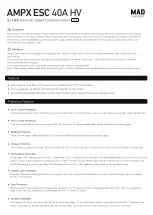
9
ENGLISH
SAFETY INFORMATION
1.
Read the information on the chemical package for
instructions and cautions on handling and applying.
2.
Wear eye and hand protection when handling and when
applying lawn or garden chemicals.
3.
Never allow children to operate the vehicle or spreader.
OPERATION
Do not use powdered lawn chemicals. They do not give a
satisfactory or consistent broadcast pattern.
1.
Estimate the size of the area to be covered and calculate
the amount of material required.
2.
Set the adjustable stop according to the flow setting
recommended in the application chart on this page. Also
refer to the instructions on the packaging for the material to
be spread.
3.
The application chart is calculated for light to heavy
coverage at a vehicle speed of 3 mph, or 100 ft. in 23
seconds. Do not exceed 6 mph.
4.
Make sure the control lever is in the "OFF" position.
5.
Fill the hopper, breaking up any lumpy fertilizer.
6.
Start the spreader in motion and then pull the control lever
forward against the adjustable stop to the "ON" position.
7.
Always move the control lever to the "OFF" position before
turning or stopping.
8.
To ensure uniform coverage, make each pass so that
the broadcast pattern slightly overlaps the pattern from
the previous pass. The approximate broadcast widths for
different materials are shown in the application chart on this
page.
9.
For rectangular areas, make two passes across the short
ends to create turning areas. For non-rectangular areas,
make two passes around the entire border.
10.
When broadcasting weed control fertilizers, make sure the
broadcast pattern does not hit evergreen trees, flowers or
shrubs.
STORING
1.
Empty the spreader after each use, storing left over
material in its original bag.
2.
Rinse the inside of the hopper and the exterior of the
spreader and dry off before storing.
3.
Store in a clean, dry area.
TYPE MATERIAL
FLOW SETTING
SPREAD WIDTH
FERTILIZER
Granular
3 - 5
2,4 m - 3 m
(8' - 10')
Pelleted
3 - 5
3 m - 3,6 m
(10' - 12')
GRASS SEED
Fine
3 - 4
1,8 m - 2,1 m
(6' - 7')
Coarse
4 - 5
2,4 m - 2,7 m
(8' - 9')
ICE MELTER
6 - 8
3 m - 3,6 m
(10' - 12')
APPLICATION CHART
SLOTTED GEAR
SHAFT SUPPORT PLATE
MAINTENANCE
1.
Oil the free spinning wheel once a year or more often as
needed.
2.
Oil the nylon bushings in the frame tube and the cross
brace once a year or more often as needed.
3.
Apply a light coating of grease to the gears as needed.
4.
Before each use make a thorough visual check of the
spreader for any bolts and nuts which may have loosened.
Retighten any loose bolts and nuts.
5.
Make sure the tires are adequately inflated. Do not inflate
beyond the maximum pressure printed on the tire.
SERVICE AND ADJUSTMENTS
REPLACING THE SLOTTED GEAR
1.
If the axle, slotted gear and sprocket assembly is
disassembled, record the positions of the parts before
they are removed. The drive wheel and sprocket positions
in relation to the slotted gear determine which direction
the vertical shaft rotates. Be sure to reassemble them in
their original positions. Add grease to the slotted gear and
sprocket after reassembling them.
FIXING A LOCKED UP SLOTTED GEAR
1.
Turn the spreader over so that the wheels are off the
ground.
2.
Loosen all three nuts on the shaft support plate just enough
so that the bolts can be turned easily with the wrench but
cannot be turned by hand.
3.
Spin the drive wheel and note how freely it spins and how
much noise the slotted gear makes.
4.
To free up the wheel and gear, tap gently on the front or
rear edge of the shaft support plate to move it slightly
forward or backward. You can also tap at the corners of the
plate to angle it slightly.
5.
Spin the drive wheel after each adjustment to see if it spins
more freely and if the gear noise is reduced.
6.
Continue making slight adjustments until you find the
position where the drive wheel spins most freely and the
gear makes the least noise.
7.
Secure the shaft support plate in this position by
retightening all three nuts that you loosened.










































